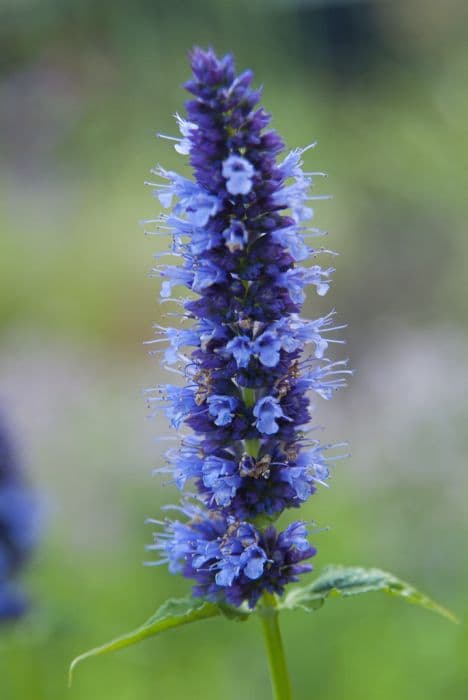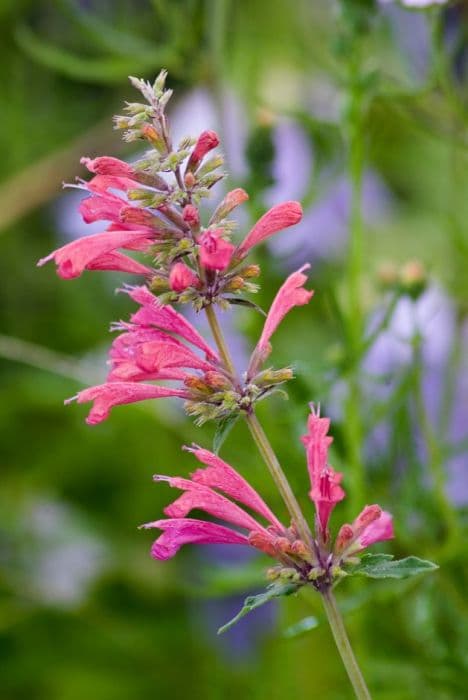Silver Thyme Thymus 'Hartington Silver' (v)

ABOUT
Thymus 'Hartington Silver', commonly known as Thyme, is a perennial herb with a distinctive appearance. This variety is celebrated for its ornamental foliage, which exhibits a striking variegation pattern. The leaves are small, oval, and slightly curved, featuring a soft green color brushed with creamy white edges, giving the impression of a delicate silver outline. This variegation adds a bright, eye-catching contrast to garden settings. Throughout the growing season, Thyme 'Hartington Silver' becomes dotted with tiny flowers. These blooms are typically lavender to purple in color, arranged in small clusters that rise slightly above the foliage, attracting bees and butterflies. Its flowers add a subtle floral display without overwhelming its graceful foliage. In addition to its visual appeal, this Thyme emits a pleasant aroma when the leaves are brushed or crushed, contributing to its sensory garden presence. Its growth habit tends to be mat-forming, creating a ground-covering effect with its interlacing stems that sprawl horizontally and root at nodes, giving the plant an interconnected, dense look.
About this plant
 Names
NamesFamily
Lamiaceae
Synonyms
Hartington Silver Thyme, Variegated Lemon Thyme, Silver Edge Thyme
Common names
Thymus 'Hartington Silver' (v)
 Toxicity
ToxicityTo humans
Thyme is generally considered non-toxic to humans when used in cooking or consumed in typical amounts. It is commonly used as a culinary herb, and there are no well-documented cases of thyme causing poisoning in humans. However, consuming any plant in excessive amounts could potentially cause stomach upset or an adverse reaction, especially in individuals with specific allergies or sensitivities. It is always advisable to introduce new herbs into the diet gradually and in moderation.
To pets
Thyme is also generally considered non-toxic to pets. It is not known to cause any significant toxicity in animals when ingested in small, culinary quantities. As with humans, overconsumption can potentially lead to gastrointestinal upset in pets. If your pet shows signs of illness after consuming thyme, it is best to consult with a veterinarian. However, such cases are rare as thyme is not commonly recognized as a hazardous plant to pets.
 Characteristics
CharacteristicsLife cycle
Perennials
Foliage type
Evergreen
Color of leaves
Variegated
Flower color
Pink
Height
6 inches [15 cm]
Spread
18 inches [45 cm]
Plant type
Herb
Hardiness zones
5
Native area
Mediterranean
Benefits
 General Benefits
General Benefits- Ornamental Appeal: Thymus 'Hartington Silver', commonly known as Silver Thyme, features attractive variegated foliage that adds visual interest to gardens and landscapes.
- Culinary Uses: Silver Thyme leaves are used as a herb in cooking, imparting a delicate flavor to a variety of dishes.
- Aromatic Qualities: The plant emits a pleasant scent when its leaves are bruised or crushed, which can add to the sensory experience in gardens or when used indoors.
- Drought Tolerance: Silver Thyme is known for being drought-tolerant once established, making it a suitable choice for water-wise gardens and xeriscaping.
- Pollinator Attraction: The flowers of Silver Thyme attract bees, butterflies, and other pollinators, thus supporting biodiversity.
- Low Maintenance: This plant generally requires minimal care, making it a good option for those looking for low-maintenance gardening.
- Ground Cover: Silver Thyme can serve as an effective ground cover, reducing weed growth and soil erosion.
- Edging and Borders: Its compact growth habit makes it ideal for use along garden edges and borders, providing a neat and tidy appearance.
- Container Gardening: This variety can be successfully grown in pots or other containers, offering versatility in garden design and space utilization.
 Medical Properties
Medical Properties- Antimicrobial activity: Thyme contains compounds such as thymol which have been linked to inhibiting the growth of bacteria and fungi.
- Antispasmodic effects: It has been traditionally used to help relieve muscle spasms and coughs.
- Antioxidant properties: Thyme has been shown to have antioxidants that can help in protecting cells from oxidative stress.
- Expectorant action: The plant has been used in herbal medicine to facilitate the elimination of mucus from the airways.
- Carminative effects: Thyme may aid in the reduction of gas and bloating by relaxing the gastrointestinal tract.
- Anti-inflammatory properties: Compounds in thyme may help reduce inflammation, which can be beneficial for various inflammatory conditions.
 Air-purifying Qualities
Air-purifying QualitiesThis plant is not specifically known for air purifying qualities.
 Other Uses
Other Uses- Thymus 'Hartington Silver', also known as Lemon Thyme, can be used as a natural insect repellent due to its strong fragrance that many pests find unattractive.
- Lemon Thyme can serve as a lawn alternative in landscaping, providing a low-maintenance, drought-resistant ground cover with a pleasant aroma when trodden on.
- The plant is suitable for creating aromatic herb pillows or sachets that promote relaxation and a good night’s sleep when placed near the bed or under a pillow.
- Lemon Thyme can be included in potpourris for its lemony scent, contributing to a fresh and invigorating blend of dried plants and flowers.
- As an ornamental plant, Lemon Thyme can be grown in hanging baskets where its variegated leaves add visual appeal and its scent can be easily enjoyed.
- During crafting, the dried stems and leaves of Lemon Thyme can be used in making scented wreaths and decorations, especially for culinary-themed designs.
- In companion planting, Lemon Thyme is beneficial alongside brassicas (like cabbage and broccoli) because its scent can deter common pests.
- The flowering of Lemon Thyme can provide a source of nectar and pollen for bees and other beneficial insects, supporting local ecosystems.
- With its compact and decorative foliage, Lemon Thyme can be used in fairy gardens and miniature landscapes as a whimsical element that simulates a tiny forest or meadow.
- Lemon Thyme can be added to baths in the form of fresh or dried leaves to create a refreshing and fragrant bath soak that revitalizes the senses.
Interesting Facts
 Feng Shui
Feng ShuiThyme is not typically used in Feng Shui practice.
 Zodiac Sign Compitability
Zodiac Sign CompitabilityThyme is not used in astrology practice.
 Plant Symbolism
Plant Symbolism- Courage and bravery: Thyme has been associated with courage since ancient times. Roman soldiers exchanged sprigs of thyme as a sign of respect and to impart courage before battles.
- Healing and purification: Thyme is known for its medicinal properties, symbolizing healing and the ability to purify both the body and the environment from negative energies.
- Passing of time: Its very name, reminiscent of the word "time," can symbolize the passage of time and can be linked with an encouragement to make the most out of every moment.
- Fairy folklore: In many cultural stories and myths, thyme is believed to be a favorite plant of fairies. It is often associated with fairy gardens and is thought to attract these mythical creatures.
- Grace and elegance: The specific variety Thymus 'Hartington Silver' with its variegated silver foliage can symbolize elegance and an appreciation for refined beauty.
 Water
WaterFor Silver Thyme, ensure the soil is dry to the touch before watering again, as it prefers a drier environment being a Mediterranean herb. Typically, this may translate to watering once every 1-2 weeks, depending on the climate and indoor conditions. When watering, provide enough water to saturate the soil without leaving the plant standing in water. For an average potted plant, use about 8-16 ounces of water, adjusting the amount as needed based on the plant's size and the environmental conditions.
 Light
LightSilver Thyme thrives best in full sun conditions, meaning it should receive at least 6 hours of direct sunlight daily. Position the plant in a south-facing window or a sunny spot in the garden where it will get abundant light. Avoid areas that are too shaded, as this can lead to poor growth and less flavorful leaves.
 Temperature
TemperatureSilver Thyme performs well in a wide range of temperatures but prefers a moderate climate. It can withstand temperatures as low as 20°F and as high as 80°F, with the ideal growing range being between 60°F and 70°F. Ensure the plant is protected from frost and extremely high temperatures, which can be detrimental to its health.
 Pruning
PruningPruning Silver Thyme is important to maintain its shape and encourage new growth. Prune the plant in early spring or after it flowers in the summer. Remove any dead or woody stems and lightly shape the plant to promote a bushier appearance. Pruning can be done a couple of times a year, usually after a flush of growth or bloom to keep it compact and healthy.
 Cleaning
CleaningAs needed
 Soil
SoilSilver Thyme thrives in well-draining soil with a pH between 6.0 to 8.0. A good mix would consist of equal parts garden soil, coarse sand, and organic compost to ensure proper drainage and fertility.
 Repotting
RepottingSilver Thyme doesn't require frequent repotting and can often be repotted every 2-3 years or as needed when it outgrows its current container or the soil becomes compacted.
 Humidity & Misting
Humidity & MistingSilver Thyme is tolerant of a wide range of humidity levels; however, it prefers a drier environment, typical of Mediterranean climates, without the need for high humidity conditions.
 Suitable locations
Suitable locationsIndoor
Ensure bright light, minimal water, and good air circulation for Silver Thyme.
Outdoor
Plant in full sun, well-draining soil, and water sparingly for Silver Thyme.
Hardiness zone
5-9 USDA
 Life cycle
Life cycleThymus 'Hartington Silver', commonly known as variegated silver thyme, begins its life cycle when seeds are sown in well-drained soil and germinate, which usually happens in the spring. Seedlings emerge and gradually develop into young plants, exhibiting the plant's characteristic variegated foliage. As the plant matures, it enters a vegetative state where it grows and spreads, forming a low, dense mat of silver-edged, green leaves. In early to midsummer, the plant reaches its flowering stage, producing small, lilac to pink flowers that attract bees and other pollinators. After flowering, variegated silver thyme produces seeds, completing its reproductive cycle, although it is often propagated by cuttings or division for consistency. In winter, the plant may die back, especially in colder climates, but since it is a perennial herb, it will regrow in the spring from its hardy root system.
 Propogation
PropogationPropogation time
Spring to early summer
Thymus 'Hartington Silver', commonly known as silver thyme, is best propagated through stem cuttings, a method typically performed in spring or early summer to capitalize on the plant's active growth phase. For propagating silver thyme using stem cuttings, select a healthy, non-flowering stem and cut a 2 to 4-inch (5 to 10 cm) length just below a node, where the concentration of hormones will aid in root development. Remove the leaves from the bottom half of the cutting to prevent decay and to facilitate rooting when planted. Dip the cut end into rooting hormone for better chances of success and insert the cutting into a well-drained potting mix or directly into garden soil if conditions are favorable. Covering the pot with a plastic bag to retain moisture can create a greenhouse effect and encourage rooting, ensuring the soil remains moist but not waterlogged. Roots typically develop within 2 to 6 weeks after which the new thyme plant can be gradually acclimatized to outdoor conditions and eventually transplanted into its final growing location.





![Bugle [Sugar Plum]](/_next/image?url=https%3A%2F%2Fplants-admin.emdemapps.com%2Fimages%2Fplants%2F%2Fimages%2F604b597956a55.png&w=640&q=75)
![Bugle [Princess Nadia]](/_next/image?url=https%3A%2F%2Fplants-admin.emdemapps.com%2Fimages%2Fplants%2F%2Fimages%2F604b5806e268c.png&w=640&q=75)


